 W
WPaseo de la Reforma is a wide avenue that runs diagonally across the heart of Mexico City. It was designed by Ferdinand von Rosenzweig in the 1860s and modeled after the great boulevards of Europe, such as the Ringstraße in Vienna and the Champs-Élysées in Paris. After the French intervention in Mexico overthrew the constitutional President Benito Juárez, the newly crowned Emperor Maximilian made his mark on the conquered city. He commissioned a grand avenue linking the city center with his imperial residence, Chapultepec Castle, which was then on the southwestern edge of town. The project was originally named Paseo de la Emperatriz in honor of Maximilian's consort Empress Carlota. After her return to Europe and Maximilian's subsequent execution, the restored Juárez government renamed the Paseo in honor of the Reform War.
 W
WThe Angel of Independence, most commonly known by the shortened name El Ángel and officially known as Monumento a la Independencia, is a victory column on a roundabout on the major thoroughfare of Paseo de la Reforma in downtown Mexico City.
 W
WAuditorio is a Mexico City Metro station located on line 7. It is one of the main metro gateways to the chic and business-related neighborhood, Polanco. The entrances to the station are on Paseo de la Reforma, one of the main thoroughfares in Mexico City.
 W
WChapultepec, more commonly called the "Bosque de Chapultepec" in Mexico City, is one of the largest city parks in the Western Hemisphere, measuring in total just over 686 hectares. Centered on a rock formation called Chapultepec Hill, one of the park's main functions is as an ecological space in Greater Mexico City. It is considered the first and most important of Mexico City's "lungs", with trees that replenish oxygen to the Valley of Mexico.
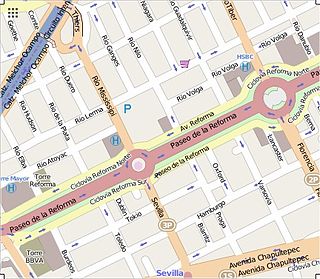 W
WChapultepec Uno R509, previously Punto Chapultepec, is a skyscraper in Mexico City at the corner of Paseo de la Reforma and Río Ródano street, immediately west of Torre Mayor. Chapultepec Uno is Mexico City's third tallest building upon completion at 241m and 58 stories high. Part of the tower will be occupied by The Ritz Carlton Mexico City which is expected to open in Autumn 2021.
 W
WThe Church of San Hipólito is a Catholic church on Mexico City's Paseo de la Reforma. It was built in 1520 by Black Spaniard conquistador Juan Garrido following a battle between the Spanish colonists and the Aztecs.
 W
WThe Monument to Cuauhtémoc is an 1887 monument dedicated to the last Mexica ruler (tlatoani) of Tenochtitlan Cuauhtémoc, located at the intersection of Avenida de los Insurgentes and Paseo de la Reforma in Mexico City. It is the work of Francisco Jiménez and Miguel Noreña in the "neoindigenismo", and was proposed to promote the new government of Porfirio Diaz.
 W
WThe Huntress Diana Fountain is a monumental fountain of Diana located in the roundabout at Paseo de la Reforma and Río Misisipí and Sevilla streets, on the border of the Colonia Cuauhtémoc and Colonia Juárez neighborhoods of Mexico City. Nearby landmarks named after the fountain include the Cine Diana and the skyscrapers Corporativo Reforma Diana and Torre Diana.
 W
WEl Ángel de la Seguridad Social is an outdoor 2013 bronze sculpture by Jorge Marín, installed along Mexico City's Paseo de la Reforma, in Mexico.
 W
WEl Caballito, officially Cabeza de caballo, is an outdoor 28-metre (92 ft) tall steel sculpture by Sebastián depicting a horse's head, installed along Mexico City's Paseo de la Reforma, in Mexico. It was dedicated on January 15, 1992.
 W
WThe Embassy of the United States of America in Mexico City is the diplomatic mission of United States of America to the United Mexican States. The embassy's chancery is situated on the Paseo de la Reforma, Colonia Cuauhtémoc, Mexico City. Ken Salazar is the current United States Ambassador to Mexico.
 W
WThe Estela de Luz is a monument in Mexico City built in 2011 to commemorate the bicentenary of Mexico's independence from Spanish rule. Its design was the winning entry in an invited competition to seek the best combination of Mexico's past and future; the design uses quartz and electric lighting to achieve this effect. The Estela de Luz is mainly used for cultural events.
 W
WFerdinand Freiherr Rosenzweig von Drauwehr was an Austrian military officer and architect.
 W
WGlorieta de la Palma is a roundabout in Mexico City that connects Paseo de la Reforma with Río Rhin and Calle de Niza. It was included in Louis Bolland's original plan for the boulevard, and finished as Reforma's second roundabout completed in 1865.
 W
WHow Doth the Little Crocodile is both a painting and an outdoor bronze sculpture by British-born Mexican surrealist artist Leonora Carrington.
 W
WHSBC Tower is a skyscraper office building located on Paseo de la Reforma in Colonia Cuauhtémoc, Cuauhtémoc, Mexico City, Mexico, which is the headquarters of HSBC Mexico. It is located opposite the Angel of Independence, and is home to the around 2,800 HSBC Mexico staff. Construction was completed in 2006, at a cost of around US$150 million. There are 23 office floors and 12 parking levels in the 136-metre-high (446 ft) tower, which is one of the tallest in Mexico City.
 W
WThe Monument to Christopher Columbus, on a major traffic roundabout along Mexico City's Paseo de la Reforma, was dedicated in 1877. The statue was removed on 10 October 2020 "for restoration purposes" two days before a planned protest. On 12 October 2021, it was announced that the statue would be replaced with The Young Woman of Amajac, a sculpture of an indigenous Huastec woman.
 W
WThe Monument to the Revolution is a landmark and monument commemorating the Mexican Revolution. It is located in Plaza de la República, near to the heart of the major thoroughfares Paseo de la Reforma and Avenida de los Insurgentes in downtown Mexico City.
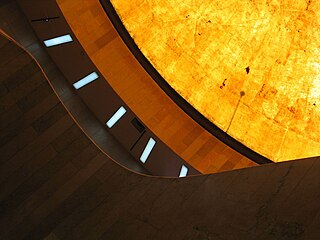 W
WThe Museo de Arte Moderno is located in Chapultepec park, Mexico City, Mexico.
 W
WThe National Museum of Anthropology is a national museum of Mexico. It is the largest and most visited museum in Mexico. Located in the area between Paseo de la Reforma and Mahatma Gandhi Street within Chapultepec Park in Mexico City, the museum contains significant archaeological and anthropological artifacts from Mexico's pre-Columbian heritage, such as the Stone of the Sun and the Aztec Xochipilli statue.
 W
WMuseo Rufino Tamayo is a public contemporary art museum located in Mexico City's Chapultepec Park, that produces contemporary art exhibitions, using its collection of modern and contemporary art, as well as artworks from the collection of its founder, the artist Rufino Tamayo.
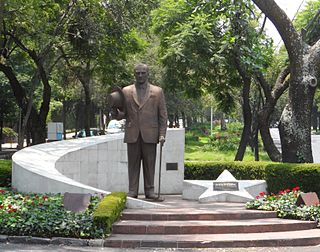 W
WMustafa Kemal Atatürk Monument is a monument located on Paseo de la Reforma in Mexico's capital, Mexico City.
 W
WThe Paseo is a major north–south parkway in Kansas City, Missouri. As the city's first major boulevard, it runs approximately 10 miles (16 km) through the center of the city: from Cliff Drive and Lexington Avenue on the bluffs above the Missouri River in the Pendleton Heights historic neighborhood, to 85th Street and Woodland Avenue. The parkway holds 223 acres (0.90 km2) of boulevard parkland dotted with several Beaux-Arts-style decorative structures and architectural details maintained by the city's Parks and Recreation department.
 W
WPuerta 1808 is an outdoor sculpture by Manuel Felguérez, installed along Mexico City's Paseo de la Reforma, in Mexico.
 W
WReforma 222 is a mixed-use complex on Paseo de la Reforma just west of Avenida de los Insurgentes in the Colonia Juárez neighborhood of Mexico City. Construction started in 2004; the complex opened in November 2007 and consists of three towers designed by Mexican architect Teodoro González de León, who also designed the National Auditorium and Museo Rufino Tamayo. There is 173,000-square-metre (1,860,000 sq ft) of space and there is a glass-covered shopping center.
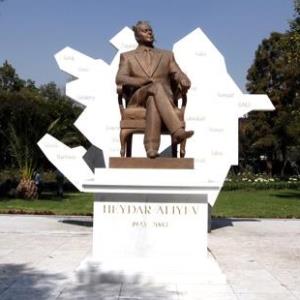 W
WThe statue of Heydar Aliyev is a bronze sculpture of the third president of Azerbaijan, Heydar Aliyev, previously installed along Paseo de la Reforma, in Chapultepec, Miguel Hidalgo, Mexico City.
 W
WThere are many statues installed along Paseo de la Reforma, in Mexico City, Mexico. Major monuments include the Angel of Independence, the Diana the Huntress Fountain, the Monument to Christopher Columbus, and the Monument to Cuauhtémoc. Other sculptures include El Ángel de la Seguridad Social, El Caballito, How Doth the Little Crocodile, and Puerta 1808, and formerly the statue of Heydar Aliyev.
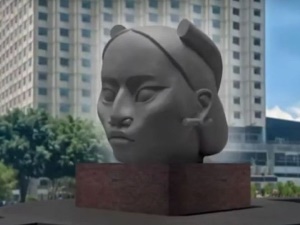 W
WTlalli is a still-in-progress sculpture of a large indigenous woman's head by contemporary artist Pedro Reyes. It had been proposed to replace the Monument to Christopher Columbus along Mexico City's Paseo de la Reforma.
 W
WThe Torre BBVA México is a skyscraper on Paseo de la Reforma in Colonia Juárez, Mexico City. It is the headquarters of BBVA México, Mexico's largest bank. Upon its completion in 2015 it became the second tallest building in Mexico City at 235 metres (771 ft) and 50 stories high. However by 2018 it is expected to be the fourth tallest in Mexico, after Torre KOI, Torre Reforma and Punto Chapultepec.
 W
WThe Torre Diana is a 33-story, 158-metre (518 ft) skyscraper at Río Lerma street #232, at the corner of Río Misisipí, just off the city's iconic boulevard, Paseo de la Reforma in the Colonia Cuauhtémoc neighborhood near the Diana the Huntress fountain.
 W
WThe Torre Mayor is a skyscraper in Mexico City, Mexico. With a height of 225 meters to the top floor and 55 stories, it is the third tallest building in Mexico. It was surpassed in height by Torre BBVA Bancomer in 2015, which in turn was surpassed by Torre Reforma. From its completion in 2003 until 2010 it was also the tallest building in Latin America. The Torre Mayor was developed by Canadian businessman Paul Reichmann, who also maintained part ownership until his death in 2013. It is also part-owned by a group of institutional investors. The building was designed by the architectural firms of Zeidler Partnership Architects and Executive Architects Adamson Associates Architects, both of Toronto. The structural engineers and designers were The Cantor Seinuk Group from New York City in association with Enrique Martínez Romero S.A. in Mexico City.
 W
WThe Torre Reforma is a Mexico City skyscraper with a height of 807 feet (246 m) to the roof and housing 57 stories, in 2016 it became the tallest skyscraper in Mexico City, exceeding both Torre BBVA Bancomer at 771 feet (235 m) located just across the street, and Torre Mayor at 739.5 feet (225.4 m) located next to it.
 W
WThe Women Who Fight Roundabout is a temporary public sculpture installed to honor the victims of femicide in Mexico. It was installed on the afternoon of 25 September 2021 by a group of feminists, who placed it on the empty plinth where a statue of Christopher Columbus had previously been. The site, a roundabout on Paseo de la Reforma Avenue in Cuauhtémoc, Mexico City, was also symbolically renamed as "Glorieta de las mujeres que luchan".